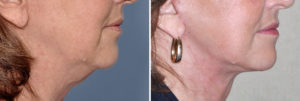
What creates that ‘operated’ look is nearly the same in most patients. The face appears too tight, pulled back, and abnormal. In its most severe form, an actual line may be seen running from the corner of the mouth backward towards the ear. (flatteringly referred to as the Joker Line) While there are other obvious signs of having had a facelift, this is certainly the one that patients fear the most. And it is one that plastic surgeons can control. It is usually the result of pulling back too much skin and trying to work out every imperfection. One of the ways to avoid this problem is to manage the patient’s expectations from the beginning. A facelift will do nothing for the mouth area, such as lifting up the corners or flattening the fold between the lip and cheek. (nasolabial fold) When you push the facelift to create changes in this area, the pull is too hard and too much skin is being removed. If a patient wants improvement in this area as well, other procedures with the facelift that directly address those problems need to be done. I have found that some patients want a facelift because they believe it will have a great impact on the mouth area…which is a misconception and a set up for disappointment.
When you put it into perspective, it is much better to have a non-obvious facelift result with a few residual lines and wrinkles than perfectly smooth skin that looks like your face is in a wind tunnel! While no plastic surgeon wants a patient to be disappointed (or hear complaints after surgery about this and that which still remains), the patient needs to make a preoperative choice. The smoothest result which may look obvious or a natural-looking facelift result that leaves some loose skin or wrinkles behind. Most, if not all, patients will choose the latter. By knowlingly make this choice, the patient is being educated and their expectations about the result are being managed.
Other less obvious evidences of having a facelift would be the result of poor scar placement around the ears or an altered temporal hairline (tuft of hair in front of your ear) that is moved up too high. In my opinion, proper incision placement is one of, if not the most, important technical aspects of a facelift. Hiding scars around the ear and hairline well, with an adequate but not overdone tightening of the skin, are what makes for the most natural and best-looking facelift results.
Dr. Barry Eppley
Indianapolis, Indiana


